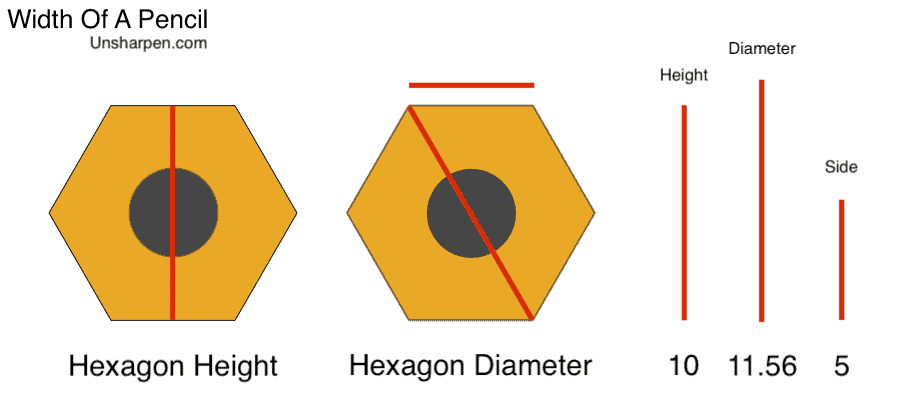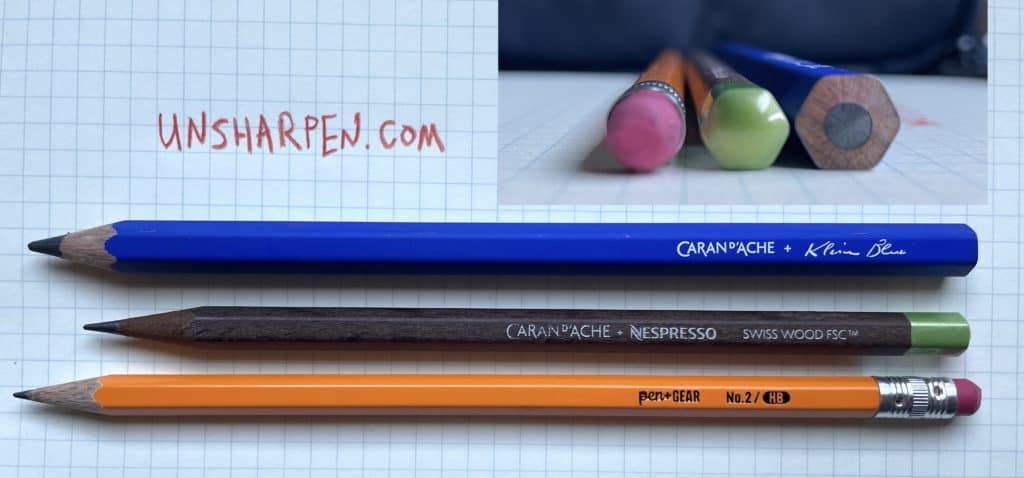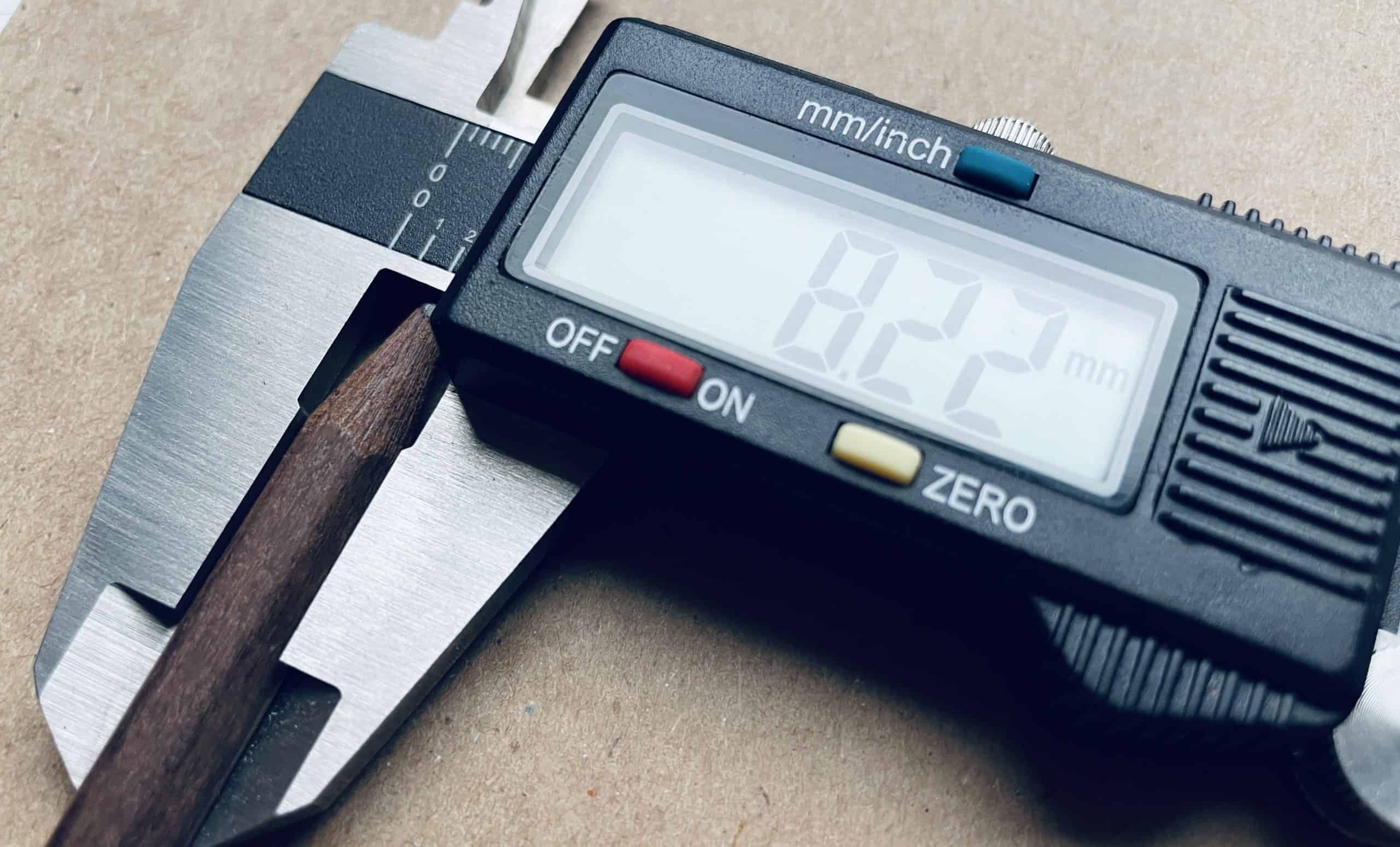It might seem basic, or even obvious, but a common question people ask is, “How wide is a wood pencil?”
The answer, of course, is “it varies…” We did some testing to see just how wide a range of popular pencils are.
No Standard Pencil
There is no ISO, ANSI, or other standards around wooden pencils. This means that wooden pencils come in all sorts of shapes and sizes. Some are round, some are hexagonal, some are long, and some are short. There are triangular pencils, jumbo pencils, carpenter pencils, and all matter of other types of pencils, but this article will focus on the classic hexagonal and round designs — the sort of pencil you’d see in a school or (in the past) an office.

How To Measure A Pencil’s Width
As many pencils are hexagons, a bit of geometry is required to decide how we will determine their width. You could measure the width as the distance from one flat side to another, which we will call the height, in order to avoid confusion. Or you could measure the distance from vertex to vertex, which is essentially the diameter. The distance between vertices is also the widest point of the pencil and, if you were to spin the pencil around its short axis and form a circle, this is the distance that would be the diameter of the circle that was formed.
So, for the purpose of this research, we will say that the width of a pencil is its diameter — the widest point of the pencil. This is useful because it will normalize hexagon- and circle-shaped pencils as well as be the determining factor in which sharpeners a pencil will fit a pencil.

Width Of A “Normal” Pencil
According to Wikipedia, a common student pencil, usually known as a #2 pencil in the United States, is about 7 mm from side to side and a just about 7.6 mm in diameter (1/4 inch and 9/32 inch respectively).
Keep in mind the geometry of hexagons (like the height being exactly 2x the length of a side) won’t perfectly apply because most hexagonal pencils have slightly rounded corners.
Wooden Pencil Widths
Here are some measurements we took from wooden pencils in our collection…
| Pencil | Shape | Width (mm) |
| Amazon Basics Wood | Hexagonal | 7.7 |
| Calepino #2 | Hexagonal | 7.4 |
| Caran d’Ache Nespresso | Hexagonal | 8.2 |
| Caran d’Ache Swiss Wood | Hexagonal | 8.2 |
| Daran d’Ache Yves Klein Maxi | Hexagonal | 9.8 |
| Colleen No. 710 | Hexagonal | 7.7 |
| Faber-Castell Perfect Pencil | Round | 7.2 |
| Faber-Castell 9003 (Chisel Point) | Hexagonal | 7.7 |
| General’s Charcoal Pencil | Round | 7.5 |
| General Pencil Kimberly 525 | Hexagonal | 7.6 |
| Kita-Boshi Vermillion 9351 | Round | 7.7 |
| Mitsubishi 1326 | Hexagonal | 7.5 |
| Mitsubishi Hi-Uni | Hexagonal | 7.9 |
| Natural Stripes Be Bold | Hexagonal | 7.7 |
| Staedtler Mars Lumograph | Hexagonal | 7.4 |
| Staedtler Wopex | Hexagonal | 7.5 |
| Tomboy Mono 100 | Hexagonal | 7.9 |
| Tomboy 4007 | Hexagonal | 7.7 |
In case you are in need of reference points in the pen world, here are some sample widths of pens that have a consistent, column-like shapes:
- Bic Cristal: 8.1 mm
- Leughtturm1917 Drehgriffel: 9.3 mm
- Rotring 600 Ballpoint: 9.2 mm
- Sakura Ballsign: 8.6 mm
Pens are, on the whole, slightly wider than wooden pencils. This even includes pens that have shape that seems to be inspired by a pencil, like the Bic Cristal.
Wrapping Up
So, if you were to ask, “How wide is a pencil?” and wanted a single number as a reply, we’d say 7.7 millimeters, or 0.30 inches, or 19/64 of an inch.
